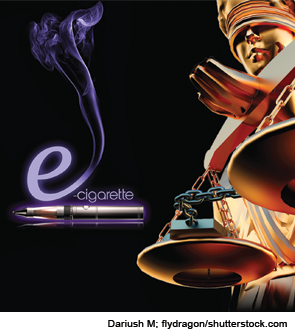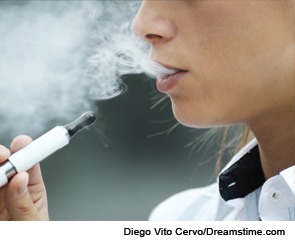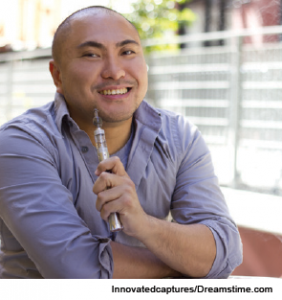Explore This Issue
December 2014Otolaryngologist Laurence DiNardo, MD, knows a nurse who has quit smoking traditional cigarettes, but now she’s using the electronic version. The vaporizer, as electronic cigarettes are often referred to, is a step in the woman’s process toward eventually weaning herself off of nicotine.
Could the largely untested e-cigarette be viewed as an improvement over the once ubiquitous Marlboro Red? Not really—not in Dr. DiNardo’s eyes. He considers e-cigarettes a nicotine delivery system, one that runs on batteries and includes a liquid composed, at least in part, of propylene glycol.
Further, that system comes with a host of questions that, to date, have few answers. How safe are e-cigarettes? What is their long-term effect on the mouth and throat, where otolaryngologists have for so long seen the damage caused by traditional cigarette use? What about the “e-liquids” these cigarettes use? How is the dosage of nicotine regulated? What is the cumulative effect of their longtime consumption? Do these products actually help people to quit smoking?
“On the surface, it sounds like it would be a healthier alternative to tobacco use, but it’s still the Wild West out there in terms of these unregulated nicotine dispensers—which is essentially what they are,” said Dr. DiNardo, MD, FACS, the Peter N. and Julia Pastore Professor and chair of the department of otolaryngology/head and neck surgery at Virginia Commonwealth University Health System in Richmond.
There is a national spotlight on e-cigarettes as the U.S. Food and Drug Administration (FDA) weighs how to regulate them, and it’s a process otolaryngologists are watching closely, given the prevalence of tobacco-related cancer cases. An April proposal sought to exert the FDA’s authority over e-cigarettes and other tobacco products as an extension of the Family Smoking Prevention and Tobacco Control Act of 2009.
No decision has been made yet on the rule, and no timeline for a decision has been announced.
Fire Up the Debate
The debate has stirred passions in otolaryngology circles, with perhaps none so involved as Robert Jackler, MD, the Edward C. and Amy H. Sewall Professor and chair of otorhinolaryngology at Stanford University School of Medicine in Stanford, Calif. In 2007, Dr. Jackler and his wife founded Stanford Research into the Impact of Tobacco Advertising (SRITA), which looks into the tobacco industry’s outreach to consumers. The group’s 20,000 collected ads are housed at the National Museum of American History, part of the Smithsonian Institution.
Dr. Jackler sees e-cigarettes as potentially safer than tobacco-combustible cigarettes, but that doesn’t mean he’d feel comfortable calling them safe, particularly as there’s no research on the health effects of 10, 20, or 30 years of inhaling “propylene glycol and glycerin into the mouth, throat, larynx, and lungs.” Dr. DiNardo added that while some may argue that the chemicals in the liquid have “long been ingested in other products, inhaling them may be another matter.”
“Those are all aldehydes, ketones, and chemicals that are being inhaled into the lungs,” Dr. Jackler said. “They come from the food industry, where those flavorants are designed to be swallowed into the [gastrointestinal] tract, but nobody really knows if, over 10 or 20 years [of] inhaling all day long, that kind of vapor can be problematic to people and cause injury to the lungs, larynx, and voice.”
 On the surface, [an e-cigarette] sounds like it would be a healthier alternative to tobacco use, but it’s still the Wild West out there in terms of these unregulated nicotine dispensers—which is essentially what they are.—Laurence DiNardo, MD
On the surface, [an e-cigarette] sounds like it would be a healthier alternative to tobacco use, but it’s still the Wild West out there in terms of these unregulated nicotine dispensers—which is essentially what they are.—Laurence DiNardo, MD The lack of evidence-based data makes formulating recommendations on the use of e-cigarettes a thorny topic. Kristen Otto, MD, an otolaryngologist at the Moffitt Cancer Center in Tampa, Fla., can’t recommend the product to her patients. Dr. Otto’s clinical focus is head and neck surgical oncology and microvascular reconstructive surgery for head and neck cancer defects, and patients in those groups are at particular risk of problems associated with nicotine use. “These people are going to be at much higher risk of failure of their reconstruction with the high nicotine doses than just the standard cancer-causing agents in the tobacco and the tar,” she said. “So I’m definitely somebody who would tell patients that they can’t do e-cigarettes or nicotine patches before the big cancer reconstructive surgery, because of the nicotine effects on the cardiovascular system. But the direct association with oral or head and neck cancers, we can’t really make at this time.”
To underscore the nascent views on e-cigarettes, Dr. Otto noted that she has seen them used on her campus in Florida. “There’s this perception … that this is not really smoking,” she said. “I’ve actually seen people wandering around Moffitt Cancer Center—a cancer center, where you would think the last thing you would want to do is to pull out a cigarette or a cigarette-like device, and yet people have them. “I think we all have to be aware that it’s now more like a public health issue,” she said.
So what should an otolaryngologist say to a patient or a patient’s family member if the habit is one that people feel comfortable indulging in even in the halls of a cancer center?
“What I tell my patients, and I try to educate them as much as I can, is that, health-wise, e-cigarettes are probably more healthy for you than a [traditional] cigarette,” said Dr. DiNardo. “My advice overall, though, is to pursue a smoking cessation program, because as far as we know at the moment, e-cigarettes aren’t necessarily going to stop you from smoking or really curb your addiction to nicotine, so it’s not necessarily a way out.”
Moving Forward
The discussion of e-cigarettes and their potential regulation, of course, hangs on the decision of the FDA, which accepted comments on its proposed rule through early August. “We cannot speculate on when FDA will issue a final rule,” a spokeswoman told ENTtoday. “However, the agency intends to work as quickly as possible to review comments.”
Dr. Jackler believes that otolaryngologists, as members of a specialty intimately familiar with the deleterious health impact of smoking, are in prime position to advocate for the regulation of e-cigarettes. In addition to cancers of the mouth, throat, larynx, and pharynx, “smokers tend to get laryngitis, [and] smokers tend to have sinu-nasal conditions, chronic leukoplakia, and sores that don’t heal,” he added. “But also, if you’re doing surgery and someone’s a smoker, several things happen. One, wounds don’t heal as well. Two, they have limited lung capacity, so you have more complications after surgery in people who are smokers, or more instances of pneumonia, more instances of bronchospasm, and things like that. Smoking is a vaso-constrictant, and so if you’re doing a reconstruction flap, for example, flaps have a much higher rate of failure due to insufficient blood supply in smokers than they do in nonsmokers.”
Dr. Jackler urges his colleagues to get involved on local and national levels to push for taxation of e-cigarettes, as well as their regulation, and to push for national drugstore chains to follow the lead of CVS, which banned the sale of tobacco products, including e-cigarettes. In fact, on the CVS website, the company noted research that showed e-cigarettes did little to curb tobacco-combustible smoking.
Furthermore, Dr. Jackler rejects the arguments of those who say regulation of e-cigarettes is a slippery slope because the devices have not yet been proven to have dangers. “I do not believe it’s a slippery slope, because there is but one leading cause of death in America,” Dr. Jackler said. “You need to eat, but you don’t need to smoke. Tobacco products are the only consumer products that are deadly when used as directed. They’re very different and so that’s what e-cigs are doing now, and it’s concerning a lot of us in public health.”
Richard Quinn is a freelance medical writer based in New Jersey.


